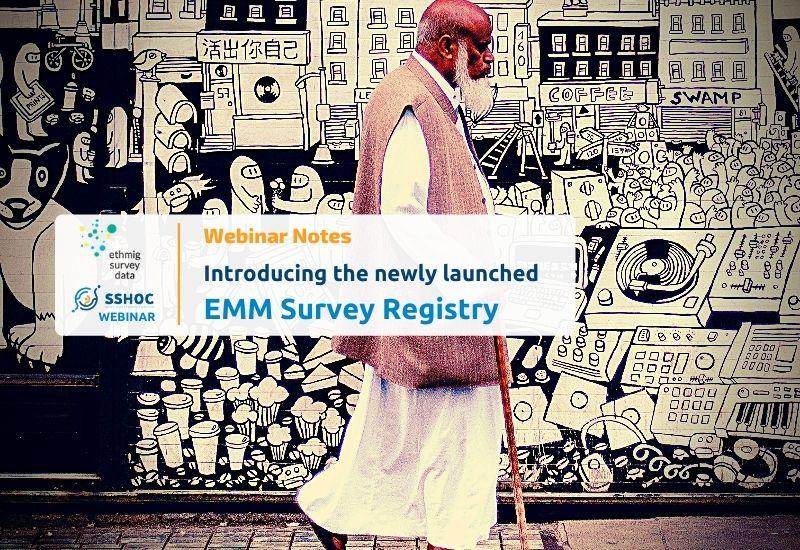
- Social Sciences & Humanities Open Cloud
WEBINAR NOTES: Introducing the newly launched EMM Survey Registry

Date:
09 November 2020
During a webinar held on 26 October 2020, speakers Laura Morales and Ami Saji (Sciences Po) introduced participants to the recently launched EMM Survey Registry, a free, FAIR-aligned tool displaying data from more than 800 quantitative surveys undertaken with EMM populations in Europe and neighboring countries. The live beta version offers metadata for some 480 surveys across 14 different countries.
While quantitative surveys of EMM (ethnic and migrant minority) populations can provide valuable insights into the migrant integration experience, the survey data is often underutilised by researchers and policymakers because it is difficult to find, access, and reuse. The registry was developed by the ethnic and migration studies data community, organised around COST Action Ethmigsurveydata, in collaboration with SSHOC (Task 9.2) expressly to tap this unmet potential.
Image source: EMM Survey Registry landing page
A ‘FAIR’ tool for EMM survey data
At its core, the EMM Survey Registry is intended to be a user-friendly and user-centric tool. It is also envisioned to be a single access point to metadata about quantitative surveys undertaken (primarily) in Europe since January 2000 with EMM respondents. Given these objectives, the FAIR principles naturally became the framework for the EMM Survey Registry design. The EMM Survey Registry promotes the FAIR principles in the following ways:
Findable
- Existing EMM surveys conducted in Europe are easier to locate, because the EMM Survey Registry acts as a living ‘census’.
- The metadata are easy to navigate and understand due to the systematic documentation of the metadata and the user-friendly interface of the tool.
Accessible
- The EMM Survey Registry makes all of its metadata publicly available online.
- For each survey, the metadata include detailed information about how to access the data set(s), technical documentation, questionnaire(s) and other relevant publications whenever possible.
Interoperable
- The metadata are set up in both human- and machine-readable formats.
Reusable
- The metadata are detailed, informative, organised and structured; the metadata itself can be reused for research.
- Reuse of the survey is promoted and facilitated, since the metadata include information about how to access the relevant original sources (e.g. data set(s), technical documentation) whenever possible.
The current state of the EMM Survey Registry
The beta version of the EMM Survey Registry, which was officially launched in spring 2020, has a fully functional front-end and currently displays metadata for almost 480 surveys from 14 different countries. Users can freely explore the front-end of the EMM Survey Registry and learn about the already included surveys through the various front-end functionalities:
- Keyword search: Users are able to look for specific surveys using a keyword search based on Boolean logic.
- Simple filtering: Users are able to refine their search results using 15 different filters (i.e. metadata variables from the EMM Survey Registry’s metadata schema).
- Advanced filtering: Users can refine their search with up to 28 filters.
- Summary of applied filters: After a user applies all of their desired filters, a summary of their selection is displayed above the list of surveys.
- Sorting: Users are able to sort the list of surveys based on country, scope (national or subnational/local level), region, start/end dates, EMM target population and sample size (achieved).
- Abbreviated view of the metadata compiled for a survey: When viewing the list of surveys, users are presented with an abbreviated view of a survey’s metadata that provides users with the critical information about a survey, so they can quickly decide whether or not the survey is of interest to them.
- Full view of the metadata compiled for a survey: Each survey captured on the EMM Survey Registry is set up with its own page that provides the full view of the compiled metadata. As the full view contains an immense amount of information, it is structured into sections and offers a navigation menu.
- XML files of the metadata: For each survey, the compiled metadata can be downloaded as an XML file by clicking on the “XML” icon. The XML file that is generated provides the actual metadata to conform with DDI Codebook.
The back-end of the EMM Survey Registry, which is where all the metadata is managed, is also fully functional. Currently, its access is limited to the administrators of the EMM Survey Registry, because the protocol of granting access has not been yet established; nonetheless, its functionalities were showcased in the webinar. In the coming months, the back-end will be opened up to external users, so that they can contribute their own metadata to the EMM Survey Registry.
Sustaining the EMM Survey Registry: An opportunity for collaboration
To ensure that the EMM Survey Registry can serve as a ‘one stop shop’ to learn about EMM surveys in the long-run, it needs the support of data producers and data users:
Data producers: Once the back-end is opened up to external users, you will be able to request an account. Using your issued account, you will then be able to contribute metadata about your own survey(s), with support/oversight from the administrators of the EMM Survey Registry.
Data users: As the EMM Survey Registry expands its collection of metadata, you are highly encouraged to use the tool and its metadata to test whether it can be adeptly leveraged for your respective research or policy-based needs. All feedback is welcomed and can be directed to: sshoc.project@sciencespo.fr
Eager for more?
For more information about the ethnic and migration studies data community and the EMM Survey Registry:
- Webinar recording: https://www.youtube.com/watch?v=UFRj6Lz0v_w
- Webinar presentation: https://zenodo.org/record/4134061#.X6UfpEJKhZ0
- Publications from the Ethnic and Migration Studies Data Community: https://zenodo.org/communities/ethmigsurveydata/
- EMM Survey Registry home page: https://ethmigsurveydatahub.eu/emmregistry/
- Ethnic and migration studies data community website: https://ethmigsurveydatahub.eu/
- Associated SSHOC project report D9.4 Database with the metadata of surveys to EMMs across Europe
Article written by Ami Saji
Photo by Clem Onojeghuo on Unsplash
Catalogue:
Ethnic and Migrant Minority Survey Registry
